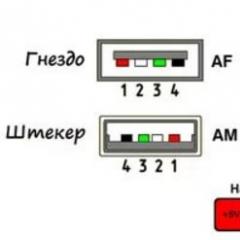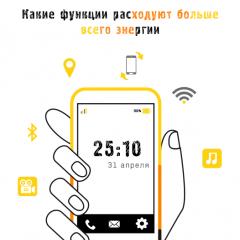USB connection with wires. USB pinout by color. Types of USB connectors
Most modern mobile phones, smartphones, tablets and other wearable gadgets support charging via a USB mini-USB or micro-USB socket. True, it is still far from a single standard, and each company is trying to make the pinout in its own way. Probably to buy a charger from her. Well, at least the USB plug and socket itself were made standard, as well as the supply voltage of 5 volts. So with any charger-adapter, you can theoretically charge any smartphone. How? and read on.

Pinout USB connectors for Nokia, Philips, LG, Samsung, HTC
Nokia, Philips, LG, Samsung, HTC and many other brands of phones will only recognize the charger if the Data+ and Data- pins (2nd and 3rd) are shorted. You can short-circuit them in the USB_AF socket of the charger and safely charge your phone through a standard data cable.

Pinout of USB connectors on the plug
If the charger already has an output cord (instead of an output jack) and you need to solder a mini-USB or micro-USB plug to it, then you do not need to connect pins 2 and 3 in the mini/micro USB itself. At the same time, you solder plus on 1 contact, and minus - on the 5th (last).

Iphone USB pinout
For iPhones, the Data + (2) and Data- (3) pins must be connected to the GND pin (4) through 50 kOhm resistors, and to the + 5V pin through 75 kOhm resistors.

Samsung Galaxy Charging Connector Pinout
To charge the Samsung Galaxy, a 200 kΩ resistor between pins 4 and 5 and a jumper between pins 2 and 3 must be installed in the USB micro-BM plug.

Pinout of USB connectors for Garmin navigator
A special data cable is required to power or charge your Garmin navigator. Just to power the navigator through the cable, you need to short-circuit pins 4 and 5 in the mini-USB plug. For recharging, you need to connect pins 4 and 5 through an 18 kOhm resistor.

Pinout schemes for charging tablets
Almost any tablet computer requires a large current to charge - 2 times more than a smartphone, and charging through the mini / micro-USB socket in many tablets is simply not provided by the manufacturer. After all, even USB 3.0 will not give more than 0.9 amperes. Therefore, a separate nest is placed (often of a round type). But it can also be adapted to a powerful USB power source if you solder such an adapter.

Samsung Galaxy Tab Charging Socket Pinout
To properly charge the Samsung Galaxy Tab tablet, a different scheme is recommended: two resistors: 33 kOhm between +5 and the D-D + jumper; 10 kΩ between GND and jumper D-D+.

Charging port pinout
Here are some diagrams of the voltages on the USB pins, indicating the value of the resistors that allow these voltages to be obtained. Where a resistance of 200 ohms is indicated, a jumper must be installed, the resistance of which should not exceed this value.
Charger Port Classification
- SDP(Standard Downstream Ports) - data exchange and charging, allows current up to 0.5 A.
- CDP(Charging Downstream Ports) - data exchange and charging, allows current up to 1.5 A; hardware recognition of the port type (enumeration) is performed before the gadget connects the data lines (D- and D +) to its USB transceiver.
- DCP(Dedicated Charging Ports) - charging only, allows current up to 1.5 A.
- ACA(Accessory Charger Adapter) - PD-OTG operation in Host mode is declared (with connection to PD peripherals - USB-Hub, mouse, keyboard, HDD and with the possibility of additional power), for some devices - with the ability to charge PD during an OTG session .
How to remake the plug with your own hands
 Now you have a pinout diagram for all popular smartphones and tablets, so if you have the skill of working with a soldering iron, there will be no problems with converting any standard USB connector to the type you need for your device. Any standard charging, which is based on the use of USB, involves the use of only two wires - this is + 5V and a common (negative) contact.
Now you have a pinout diagram for all popular smartphones and tablets, so if you have the skill of working with a soldering iron, there will be no problems with converting any standard USB connector to the type you need for your device. Any standard charging, which is based on the use of USB, involves the use of only two wires - this is + 5V and a common (negative) contact.
Just take any charging-adapter 220V / 5V, cut off the USB connector from it. The cut end is completely freed from the screen, while the remaining four wires are stripped and tinned. Now we take a cable with a USB connector of the desired type, after which we also cut off the excess from it and carry out the same procedure. Now it remains just to solder the wires together according to the diagram, after which the connection is isolated each separately. The resulting case is wrapped on top with electrical tape or tape. You can pour hot glue - also a normal option.
Content:Bonus: all other connectors (jacks) for mobile phones and their pinouts are available in a single large table -.
In every computer and other similar devices, the most popular is the USB connector. With the help of a USB wire, it became possible to connect more than 100 units of series-connected devices. These buses allow you to connect and disconnect any devices, even while the personal computer is running. Almost all devices can be charged through this connector, so there is no need to use additional power supplies. The color-coded USB pinout helps you pinpoint which type of device a particular bus belongs to.
USB device and purpose
The first ports of this type appeared in the nineties of the last century. After a while, these connectors were updated to the USB 2.0 model. The speed of their work has increased by more than 40 times. Computers now have a new USB 3.0 interface that is 10 times faster than the previous version.
There are other types of connectors of this type, known as micro and mini USB, used in modern phones, smartphones, and tablets. Each bus has its own or pinout. It may be required if you need to make an adapter from one type of connector to another with your own hands. Knowing all the subtleties of the location of the wires, you can even make a charger for a mobile phone. However, be aware that the device may be damaged if connected incorrectly.
The USB 2.0 connector is made in the form of a flat connector with four pins. Depending on the purpose, it is labeled as AF (BF) and AM (BM), which corresponds to the everyday name "mother" and "dad". Mini and micro devices have the same markings. They differ from ordinary tires in five contacts. The USB 3.0 device looks like the 2.0 model, except for the internal design, which already has nine pins.
Pinout of USB 2.0 and 3.0 connectors
The wiring in the USB 2.0 model is arranged in the following order:

- A red conductor to which a DC supply voltage of +5V is supplied.
- A white conductor used to transmit information data. It is indicated by the marking "D-".
- The conductor is colored green. It also conveys information. It is marked as "D+".
- Black conductor. Zero is applied to it, supplying its voltage. It is called the common wire and is indicated by its own label in the form of an inverted T.
The layout of the wires in the 3.0 model is completely different. The first four contact wires are fully compatible with the USB 2.0 connector.

The main difference between USB 3.0 is the following wires:
- Conductor number 5 is blue. It transmits information with a negative value.
- Conductor No. 6 yellow, like the previous contact, is designed to transmit information that has a positive value.
- Conductor No. 7 is used as an additional ground.
- Conductor No. 8 is purple and Conductor No. 9 is orange. They perform the function of receiving data, respectively, with a negative and positive value.
Pinout of micro- and mini-USB connectors
Micro USB connectors are most commonly used in tablets and smartphones. The micro usb pinout differs from standard buses in a much smaller size and the presence of five pins. They are labeled as micro-AF (BF) and micro-AM (BM), which corresponds to "mother" and "dad".

Micro-USB desoldering is done in the following order:
- Contact #1 is red. Voltage is applied through it.
- Contacts No. 2 and 3 in white and green are used for transmission.
- Pin No. 4, purple, has special functions in certain tire models.
- Contact No. 5 black is the neutral wire.
The pinout of the mini USB connector by color is performed in the same way as in micro-USB connectors.
How to connect phone to computer? To solve this problem, there are several ways to pair smartphones and other mobile devices with a personal computer or laptop. All methods are quite popular and often used. These include:
- bluetooth.
- WiFi.
The first of them is used the least often, and it can only be used to transfer small files and data. For example, for phone number books. This method, in addition to low speed and a small range, will also require a significant part of the battery charge. Plus, you need to have a bluetooth receiver for your PC, which also costs money. But there are, of course, some motherboards that have a built-in transceiver. Then the task becomes easier. But what about the other computer? Therefore, this method has the least distribution.
The second option is the best and most commonly used. This is due to many factors:
- speed;
- convenience;
- the ability to transfer large files;
- multifunctionality.

For this you will need:
- configure and enable 3G or 4G Internet on the phone itself;
- Kies must be installed on the computer;
- connect the device to the PC with a USB cable;
- on the phone, you need to do the following, depending on android versions and model of the device itself:
1) Go to "Menu" -> "Settings" -> "Advanced settings / Other settings" -> "Modem and mobile hotspot" -> Select "USB modem".
2) Go to "Menu" -> "Settings" -> "Network" -> "Modem" -> Select "USB modem".
After a successful connection, the corresponding icon will appear in the upper right corner, and a new network connection will appear on the PC.
FAQ
Why does the computer not see the connected phone? To resolve this issue, you need to do the following:
- check USB cable;
- reinstall the software, this must be done with the phone disconnected from the PC;
- check the USB connection on another PC.
Install the required drivers. If you still have the packaging from the USB drive, then read the instructions and find out if the correct driver is included in the kit. A driver is a software component that allows data to be exchanged between a flash drive and a computer. All operating systems download the necessary drivers automatically, but if you are not connected to the Internet or need to install the driver manually, then just follow the instructions.
- In this case, the driver is usually included on the bundled disk. Place the CD in the drive and follow the prompts.
Turn on the device and computer. If the USB flash drive is equipped with a power switch or a special cable, the device must be turned on before connecting to a PC. Also, don't forget to turn on your computer.
Connect the USB cable to the device (if necessary). Typically, small storage devices have a built-in USB connector, but portable hard drives and other devices may come with a cable. Connect the cable to the device to then connect it to the computer.
Locate the USB port on your computer. The connector will look like a small rectangular hole with 4 metal pins inside. Usually, a USB port is identified by the corresponding logo in the form of a circle and an arrow with three prongs. If such a device will be constantly connected to the PC, then it is better to use the port on the back of the computer. Front connectors are more convenient for quick and short-term connection.
Connect the USB cable to the computer's USB port. Decide which port you want to use, then simply plug the drive connector into it. The connector should fit snugly and effortlessly in one direction, so rotate the cable 360 degrees if you can't connect the drive.
Wait for the driver installation to complete. When you connect the device for the first time, the operating system can search for and install the necessary drivers. After a few seconds, your computer will give you an alert that the driver installation is complete and the device is ready to use. If you have already installed the drivers manually, the drive will be ready to use right away.
After completing the necessary steps, disconnect the USB drive. After work, the device should be turned off or "removed". In Windows, right-click on the USB device icon in Explorer and select "Eject". On a Mac, select and drag the drive icon to the Trash so that the Eject icon appears. After that, you need to physically remove the drive from the connector, without putting much effort.



